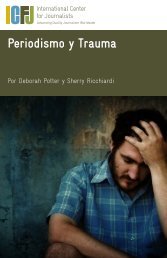Disaster and Crisis Coverage - International News Safety Institute
Disaster and Crisis Coverage - International News Safety Institute
Disaster and Crisis Coverage - International News Safety Institute
You also want an ePaper? Increase the reach of your titles
YUMPU automatically turns print PDFs into web optimized ePapers that Google loves.
<strong>Disaster</strong> <strong>and</strong> <strong>Crisis</strong> <strong>Coverage</strong><br />
Also, be sure everyone knows what happens to days off, vacations, <strong>and</strong><br />
so on, if the plan is implemented.<br />
✦<br />
✦<br />
✦<br />
✦<br />
✦<br />
✦<br />
✦<br />
A “start-up guide” that anyone in the newsroom can follow to launch<br />
immediate coverage.<br />
Responsibilities <strong>and</strong> specific assignments for newsroom personnel.<br />
Which reporters are most likely to be dispatched to the scene? Who will<br />
stay in the office for rewrite <strong>and</strong> reporting by phone? The plan should<br />
also assign duties to people from outside the newsroom to support the<br />
news effort, such as answering phones or providing food.<br />
A blank schedule to assign personnel to shifts (8 or 12 hours) for longerterm<br />
coverage.<br />
Contact information for emergency response officials, major public<br />
institutions <strong>and</strong> independent experts on disaster-related topics.<br />
Contact information for support personnel (freelancers, other news<br />
organizations outside the disaster area) who might be needed to<br />
supplement the newsroom’s staff.<br />
Contacts for renting equipment on short notice (generators,<br />
communications, transportation etc.)<br />
Background information on disasters the newsroom might have to cover.<br />
The Belgium-based Centre for Research on the Epidemiologies of<br />
<strong>Disaster</strong>s (http://www.cred.be/) maintains a comprehensive, searchable<br />
database of emergency events that can help journalists evaluate the<br />
likelihood of specific types of disasters in their country or region (http://<br />
www.emdat.be/Database/terms.html).<br />
Examples of disaster situations<br />
✦<br />
✦<br />
✦<br />
✦<br />
✦<br />
Natural disaster (hurricane, flood, tornado, blizzard, wildfire, earthquake,<br />
volcano)<br />
Accidents (plane crash, train derailment, bus crash, explosion, fire,<br />
building collapse)<br />
Hazardous material (chemical leak or spill, nuclear power plant accident)<br />
Terrorism (biological, chemical, nuclear, conventional explosive)<br />
Public safety (hostage taking, sniper attack, riot, disease p<strong>and</strong>emic)<br />
11
















